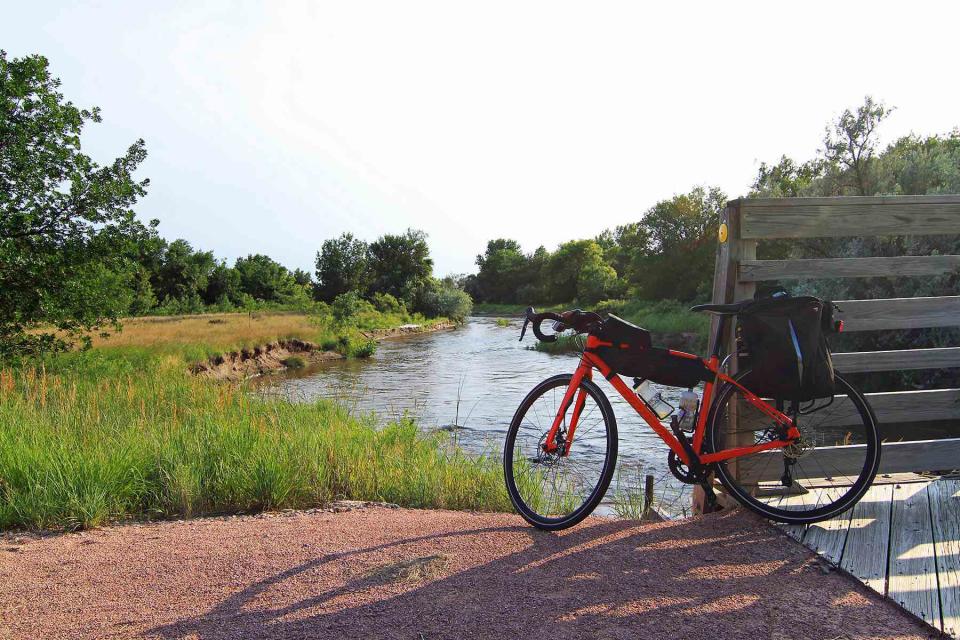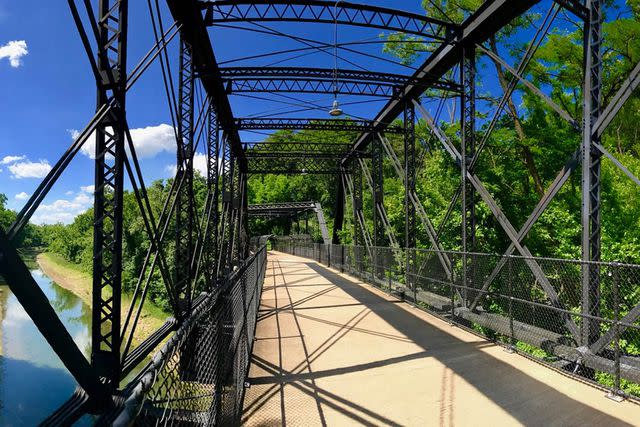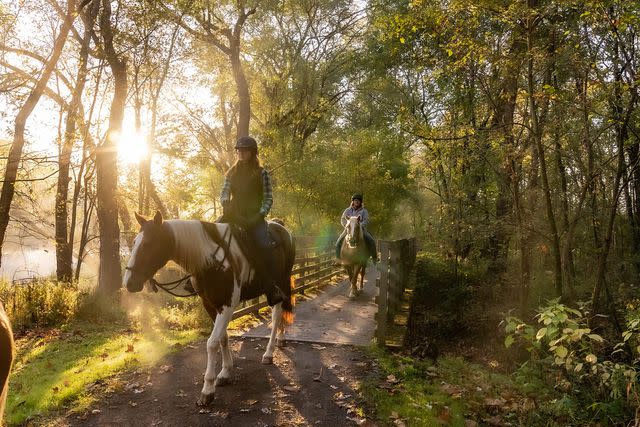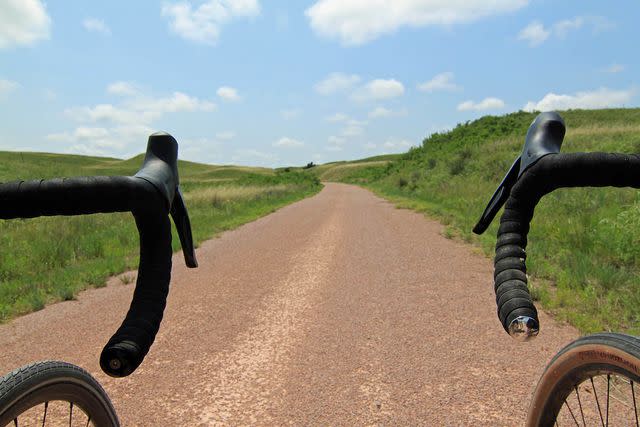The Great American Rail-Trail Will Run 3,700 Miles — From Washington, D.C. to the Pacific Ocean
Everything you need to know about the U.S. rail trail connecting the East Coast to the West.

Courtesy Rails-to-Trails Conservancy
Trails can lead us to some of the most beautiful places on Earth — a lush Hawaiian bay or analpine lake surrounded by snow-capped peaks. But trails are about more than just providing access to near-untouched corners of the globe, they’re about creating safe passage for people on their journey from Point A to Point B.
That’s the mission behind the Rails-to-Trails Conservancy, a trails advocacy organization, whose goal is to build “a nation connected by trails.” They work to turn abandoned and overrun corridors and railways into safe places for people to walk, bike, and run — including several wheelchair accessible routes (like the Little Miami Scenic Trail in Ohio).
But the crown jewel of the Rails-to-Trails Conservancy is the Great American Rail-Trail, a route that will connect Washington, D.C. to Washington State via 3,700 miles of multi-use trail. The coast-to-coast project will connect more 145 existing rail trails, greenways, and other multi-use paths in one contiguous trail. Visitors can do a segment — or two — or complete the entire cross-country route, pedaling, running, or walking across 12 states and the District of Columbia on a trail that was designed for long-distance travel.
“Imagine the incomparable experience of exploring America’s heritage by trail — its potential, its beauty and bounty, its people and places,” the Great American Rail-Trail website touts, noting that the trail will be “safe, seamless, and scenic.
The project was more than 50 percent complete by the end of 2022, and work is ongoing. Here’s what you need to know about the Great American Rail-Trail, including what to expect, when it should be completed, and what segments are already gaining popularity.
The Great American Rail-Trail Route
The 3,700-mile route will traverse the northern half of the U.S., cutting through 12 states and the District of Columbia on its ambitious coast-to-coast journey. The trail can be explored in either direction, but for simplicity, we’ll focus on the east-to-west journey, which kicks off at the steps of the U.S. Capitol in Washington, D.C. and heads west through the National Mall on Maryland's Capital Crescent Trail.

Milo Bateman/Courtesy Rails-to-Trails Conservancy
From Washington, D.C. the route dips into Maryland, Pennsylvania, West Virginia, and Ohio, before cutting into Indiana, Illinois, Iowa, and Nebraska. The route then traverses through the West, with trails connecting Wyoming, Montana, Idaho, and finally, Washington State. The final segment of the Great American Rail-Trail will be the in-progress Olympic Discovery Trail, which cuts across the Olympic Peninsula and ends at the Pacific Ocean.
What to Expect on the Great American Rail-Trail
Once it’s completed, the Great American Rail-Trail will be free of motorized travel and completely separate from vehicle traffic. The surface of the trail varies, but is designed to be accessible to walkers and bikers throughout. The goal of the route is to provide a quiet and safe place for bikers, walkers, and runners who want to explore the U.S. — be it a different corner of their state or a state on the other side of the country.
Many states and segments are already set up to accommodate long-haul trail users with hotels, campgrounds, and a community of bike enthusiasts, called Warm Showers, who open their homes to trail users in need of a place to crash. And while the route can be undertaken in one continuous journey, most people will simply enjoy the rail trail by segment. The Rails-to-Trails Conservancy estimates that “the trail will directly serve nearly 50 million people within 50 miles of the route.”
Standout Segments on the Great American Rail-Trail
The Great American Rail-Trail has a memorable start and end point — even though the two couldn’t be more different. The fully complete Capital Crescent Trail (also known as the Georgetown Branch Trail), kicks off at the U.S. Capitol, traveling through the National Mall before skirting the Potomac River. From there, the route becomes increasingly wooded and quiet as it makes its way toward the Maryland suburbs.

Renee Rosensteel/Courtesy Rails-to-Trails Conservancy
In Ohio, you won’t want to miss the Ohio & Erie Canal Towpath Trail, which connects cities like Cleveland and Akron with the stunning Cuyahoga Valley National Park. Meanwhile, in Iowa, the picturesque Cedar Valley Nature Trail, which was one of the state’s first rail trail conversions, is a great place to see wildflowers or spot Iowa’s state bird, the American Goldfinch.
As the Great American Rail-Trail passes the Iowa-Nebraska border, travelers are in for a treat: a crossing on the iconic Bob Kerrey Pedestrian Bridge, a 3,000-foot cable-suspension bridge over the Missouri River. Deeper into Nebraska, the trail meets the Cowboy Recreation and Nature Trail, the longest (and arguably most famous) rail trail in the country.

Courtesy Rails-to-Trails Conservancy
In Idaho, the ultra-scenic Trail of the Coeur d’Alenes (a Rail-Trail Hall of Fame inductee) provides views of the rugged Idaho landscape before crossing into the state of Washington, the final stop on the Great American Rail-Trail.
The trail ends with a bang, crossing into the Seattle area before heading toward the Pacific Ocean on the burgeoning Olympic Discovery Trail.
When will the Great American Rail-Trail be complete?
The Great American Rail-Trail is about halfway done. Trail-building teams in each state are working to connect completed routes in order to meet the ultimate goal of a single, continual trail that connects Washington, D.C. and Washington State.
For a full rundown of what segments are complete and which routes are either planned or in the early stages of planning, view the entire cross-country route here.
According to their website, the Great American Rail-Trail is expected to be complete “in the next few decades,” but don’t let that deter you from getting out and exploring the vast number of already-completed segments in each state.
For more Travel & Leisure news, make sure to sign up for our newsletter!
Read the original article on Travel & Leisure.

